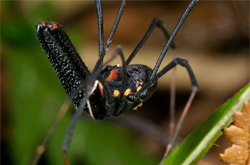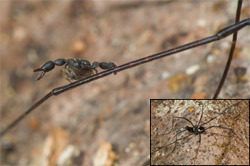-
May 19, 2014
The Mysterious Disappearing Cuttlefish -
May 19, 2014
The Evolution of Complexity -
May 19, 2014
A Tale of Two Sea Urchins -
May 19, 2014
If You Don't Have It- Steal It: Sea Slug Defenses -
February 18, 2014
Moving On Rainbow-Colored Legs: Cilia And Cteno... -
November 21, 2013
Ancient History: Tyrian Purple -
October 09, 2013
The Central Limit Theorum -
October 08, 2013
Sexual Dimorphism: The Spoonworm -
October 08, 2013
When Your Trash is Another's Treasure: Sustaini... -
September 04, 2013
Untangling DNA -
June 09, 2013
PhyloTree -
April 18, 2013
6 Tips for Achieving Invisibility -
February 28, 2013
Apolemia -
February 28, 2013
Chestnut Blight -
February 28, 2013
Nautilus -
February 28, 2013
Mud Skipper -
February 28, 2013
Glaucus atlanticus -
October 18, 2012
The Vertebrate Vascular System -
October 11, 2012
3D Printed Nematocyst -
September 20, 2012
Narcomedusae -
September 12, 2012
Doliolids -
September 12, 2012
How to Hide -
September 12, 2012
Ocean Slime -
July 05, 2012
Zoostalgia -
March 16, 2012
Echinoderm Skin -
March 16, 2012
Rhizocephala -
March 16, 2012
Jumping Spider -
March 16, 2012
Lifecycles, by Manvir Singh -
March 16, 2012
Anglerfish -
March 16, 2012
Tardigrades -
March 16, 2012
Resurrection Fern -
September 14, 2011
Passing Cloud -
June 02, 2011
Gelatinous Animals -
May 23, 2011
Hollow Trees -
May 23, 2011
Postdoc Position Available in the Dunn Lab -
May 11, 2011
Life on a Lobster Mouth -
May 04, 2011
Exciting Announcement -
March 08, 2011
Antartic Krill Love Dance -
January 28, 2011
Gyrodactylids -
January 18, 2011
Chasing Ghosts in Aotearoa -
January 10, 2011
Tangled String -
January 06, 2011
Waiting for the Bus -
January 04, 2011
Practical Computing for Biologists -
December 14, 2010
The Stomatopod Strike -
December 03, 2010
Moray Eel -
November 01, 2010
Gone Fishing -
October 26, 2010
Perspective of a Bird -
October 07, 2010
Know Your New England Bioluminescants -
October 01, 2010
Jellyfish Capsule Hotel -
September 20, 2010
Siphonophore Snacks -
September 08, 2010
What is a Cell? -
August 12, 2010
Corals and Coloniality -
July 20, 2010
Jellyfish Theater -
July 16, 2010
Axolotls and the French Intervention -
July 07, 2010
More Budding Jelly Babies -
June 24, 2010
Salty Pups -
June 17, 2010
Centerless Self -
June 08, 2010
How Do Krill Grow? -
May 26, 2010
Bone Boring Worms -
May 17, 2010
A Tale of Two Nuclei -
May 07, 2010
Be Still Its Beating Heart -
April 30, 2010
CreatureCast – Sea Stars -
April 22, 2010
Seeing the Invisible -
April 09, 2010
CreatureCast – Individuality -
March 30, 2010
Hitching a Ride -
March 18, 2010
Tube Vision -
March 08, 2010
CreatureCast – Diving for Jellies -
February 18, 2010
After the Fall -
February 10, 2010
Solar Powered Sea Slugs -
January 27, 2010
CreatureCast – Picky Females -
January 20, 2010
Spicules and droplets -
January 14, 2010
CreatureCast – Pattern Shifting Snails -
January 11, 2010
CreatureCast – Comb Jellies -
January 07, 2010
Stack of plates in action -
December 29, 2009
Making babies like a stack of plates -
December 23, 2009
CreatureCast – Marine Worms -
December 22, 2009
Pelagic plastic -
December 18, 2009
CreatureCast Episode 3 -
December 17, 2009
Thou shalt covet thy neighbor’s cnidocytes -
December 16, 2009
The art of knotting -
December 09, 2009
Star colonies of sea squirts -
December 08, 2009
Postdoc position in the Dunn Lab -
December 02, 2009
Mating when you are stuck to a rock -
November 20, 2009
Deadly bands -
November 12, 2009
Mitochondrial lenses -
November 09, 2009
Marnix Everaert -
November 06, 2009
A tale of two holes -
October 30, 2009
Fall in Rhode Island -
October 28, 2009
Glowing worms in the deep sea -
October 26, 2009
Hiding submarines beneath jellyfish -
October 22, 2009
Retractable spots -
October 20, 2009
Evolution by co-option
« Prev « Prev Next » Next »




 When collecting bugs out in the field, it can be easy to get more than one bargained for. Many flies, beetles, and other mobile beasties such as the harvestman shown above right (Megalopsalis sp. from New Zealand) find themselves regular host to hitchhikers of arachnid origin: the five orangish globules nestled among the bases of this unfortunate individual's limbs are parasitic mites hunkered down for the long haul.
When collecting bugs out in the field, it can be easy to get more than one bargained for. Many flies, beetles, and other mobile beasties such as the harvestman shown above right (Megalopsalis sp. from New Zealand) find themselves regular host to hitchhikers of arachnid origin: the five orangish globules nestled among the bases of this unfortunate individual's limbs are parasitic mites hunkered down for the long haul. One group of these tag-alongs is the pseudoscorpions — distant relatives of true scorpions, living secretive lives in forest soil and tree bark — which many would doubtless find abjectly terrifying (if they ever got larger than a few millimeters). In the second image, you can see a pseudoscorpion hanging for dear life onto the leg of another Megalopsalis (inset). There are reports of pseudoscorpions waiting eagerly around a flower for a bee pollinator to grab onto, or clustering around the pupal bores of flies just before the airborne adult emerges. The traditional interpretation of this behavior suggests that climbing aboard larger, more mobile animals is an adaptation meant to transport these tinier critters to a wider range of habitats. Others, however, have suggested that perhaps pseudoscorpions simply grab onto whatever passes by them in the hopes that they might be able to eat it.
One group of these tag-alongs is the pseudoscorpions — distant relatives of true scorpions, living secretive lives in forest soil and tree bark — which many would doubtless find abjectly terrifying (if they ever got larger than a few millimeters). In the second image, you can see a pseudoscorpion hanging for dear life onto the leg of another Megalopsalis (inset). There are reports of pseudoscorpions waiting eagerly around a flower for a bee pollinator to grab onto, or clustering around the pupal bores of flies just before the airborne adult emerges. The traditional interpretation of this behavior suggests that climbing aboard larger, more mobile animals is an adaptation meant to transport these tinier critters to a wider range of habitats. Others, however, have suggested that perhaps pseudoscorpions simply grab onto whatever passes by them in the hopes that they might be able to eat it. It's hard not to be reminded of the poet Jonathan Swift's
It's hard not to be reminded of the poet Jonathan Swift's 

















